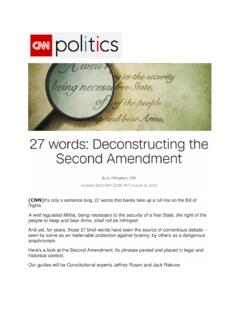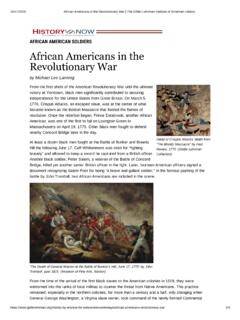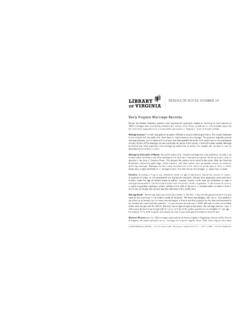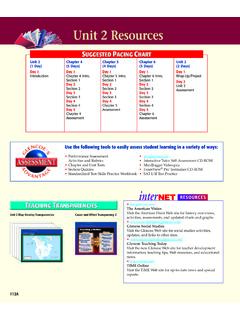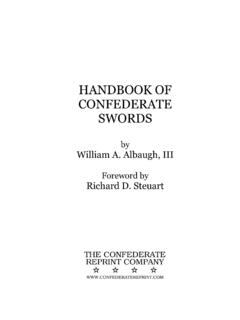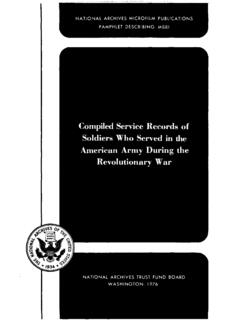Transcription of Virginia Taxes & Tax Lists for the Colonial and Early ...
1 Virginia Taxes & Tax Lists for the Colonial and Early Federal Period 1A discussion of Early VA Taxes , Tax Lists , & Censuses followed by a bibliography of published VA Tax and USCensus Substitute sources Table of ContentsVirginia Taxes During the Colonial and Early Federal PeriodCollecting Virginia TaxesColonial & Early Federal Virginia Tax RecordsQuit Rent & Land Tax RecordsTithables & Personal Property Tax ListsSpecial Taxes During the revolutionary PeriodUnderstanding the Virginia Personal Property Tax Lists of 1782 Onfor more on this subject, see my additional paper:The Annual Virginia Tithables and Tax Lists in Law, and Their InterpretationMy Abstracting Conventions for the Virginia Personal Property Tax ListsSources for Virginia Tax Lists John Barrett Robb; published 7 Aug2017 Virginia Taxes & Tax Lists for the Colonial and Early Federal Period 2 OverviewEarly Virginians were taxed on their land (real property), and on certain items of personalproperty.
2 They were also taxed by the head as polls, or as tithables . Both types of Taxes werecollected at the county level, and most of the proceeds were spent there too. The specifics variedconsiderably over the whole period here considered, not only as to rates, but in the categories ofthings and persons taxed. Certain broad generalizations can, however, be made. Land owners were taxed on land they owned in a county, regardless of where they resided. Generally, the amount of the tax was proportional to the acreage, though other factors weresometimes taken into consideration; for example, town lots more heavily taxed than rural property. The land tax probably evolved out of the old quit rent tax an annual rent paid by the feudalleaseholder to his lord. In feudal theory, there was only one property owner, the king or overlord,from whom all held their property on sufferance, and in return for various feudal duties, includingpayment of this quit rent.
3 Although this framework seems a bit anachronistic on the VA frontier,where land only began to acquire value by virtue of its settlement, and the problem was to inducesettlers to take up the land, still, it was the framework people were used to, and it did provide a meansfor the always-strapped Colonial government to raise some revenue. It seems that quite rents were asoften as not in arrears (and occasionally a property would lie forfeit therefore), and they fell entirelyinto disuse by the Early 1700s. Personal property Taxes were laid, especially from 1782 on, on certain items of luxury (like wheeledcarriages), and on certain non-real capital assets, like stud-horses, and also on state-granted ordinary (or tavern) licenses. Thus personal property Taxes may be seen as a tax on either wealth and enterprise,and they introduced an element of progressivity into VA taxation. Tithables principally comprised all white males aged 16 or over (including indentured servants),and also slaves of both sexes aged 16 or over, though the ages of tithable slaves was changedoccasionally over the years.
4 White women were never considered tithables in tax on tithables was principally a labor service tax, and the concept evolved out of the Lists keptat the county level of the able-bodied men subject to militia duty, though the main form that laborservice took was the construction and maintenance of roads. Heads of household (who might be non-tithable women, usually widows with no grown sons) were responsible for mustering their tithableson call, or for paying any personal property tax due, mostly for resident in a county were taxed for a time during the revolutionary and Early federalperiods as polls, to support colony/state as well as county government. Throughout Colonial timesthey were also taxed to support the Anglican parish in which they resided, the colony being dividednominally into parishes as well as counties, and everyone tithable (or liable for tithables), regardlessof their religion, was required to support this established slaves, indentured servants, and resident males associated with a household were are all taxedto the householder, or chargeable , the poll tax, especially at the county level where minors in ahousehold aged 16-20 were tithables, might best be understood as a tax on capital assets (labor), thanas a government bill for services available to individuals.
5 In modern usage, a poll tax is generallyunderstood as a head tax levied on voting citizens, but in Virginia until well into the 1800s only whitemale landowners were allowed to vote, and the best surrogate for the voters tax , if there had beenone, would have been the land tax. Certain persons who would otherwise be tithables, or subject to the parish levies, were madeexempt by state/ Colonial legislation (principally ministers, public officials, and during wars those inuniform), or forgiven the tax by the county authorities (chiefly the tax commissioners) on account ofage, infirmity, or general inability to pay the tax. John Barrett Robb; published 7 Aug2017 Virginia Taxes & Tax Lists for the Colonial and Early Federal Period 3 Collecting Virginia TaxesLike us moderns, Colonial Virginians had an annual tax day which was standardized statewideto 10 June (or the next day when 10 June fell on a Sunday), by an act of 1705, and reaffirmed in 1748[1],and remained thus through 1781.
6 The tax information provided by those liable for the tax wassupposed to represent conditions as of 9 June of the tax year. In Nov1781, just after the revolutionary War reached its military conclusion with the Battle ofYorktown, comprehensive reforms of the tax system were enacted, to take effect in 1782.[2] As partof this reform, tax day was changed to the 10th of March. On tax day, persons liable for Taxes on property or tithables were required to make their returnsto a county-appointed tax commissioner for the subject s district of residence, at a publicly advertisedplace usually at the county courthouse or its environs. If sick, or possessed of some other goodexcuse, the return could be deferred until the end of June. The tax commissioner was then requiredto collate these Lists , and furnish a fair copy of the whole to the August county court, where it wouldbe publicly posted to help ferret out tax cheats, with rewards for informers. Provision was also madefor the assessment to be challenged, and a few Lists of tax alterations occasionally significant financial penalties threatened concealers of tax information, compliancemust have been a chronic problem because in supplementary legislation of Oct1786,[3] the tax officialswere required to get out and ride circuit collecting the information, instead of sitting passively at thecounty courthouse waiting for the sheep to present themselves for shearing.
7 Instead of 10 March beinga universal tax return day , 10 March became the day each commissioner was supposed to begin hiscircuit, and he was supposed to note and report the actual date the information was gathered fromeach chargeable individual. However, the tax information for all was still supposed to be,nevertheless, as of Commissioners were instructed to prepare the individual s return themselves if it seemedadvisable (not everyone could read & write), then read or show it to the affected party and gain hisassent, as shown by his signature or mark. These returns were called vouchers and were then usedby the commissioner (when his collection of vouchers was complete) to make four copies of analphabetized fair copy list for delivery to the County Clerk by the end of May, along with thevouchers, so that the Clerk could audit and certify the Lists . The Clerk then returned one copy to thecommissioner for use by him, or his successor next year, kept one copy for his own records,forwarded one copy to the County Sheriff who was responsible for collecting the tax, and one copyto the State solicitor so he could audit the Sheriff.
8 What became of the original vouchers once the listshad been certified, I have not been able to sheriff, incidentally, was appointed by the Colonial or state administration, and he waspersonally liable for the full amount due from the county to the central government. That is why thesheriff was necessarily a man of substance, and was typically bonded by wealthy certified personal property tax Lists which resulted from this process were used for assessingand collecting all colony/state and county Taxes , except for the land tax. Land tax information wasgathered in the same way and at the same time by the tax commissioners, and separate land tax listswere prepared and certified. I have not been able to ascertain the details of this Hening's Statutes at Large, 3(Oct1705):258-261, and 6(Oct1748):40-442 Hening's 10(Nov1781):501-5173 Hening's 12(Oct1786):243-254 John Barrett Robb; published 7 Aug2017 Virginia Taxes & Tax Lists for the Colonial and Early Federal Period 4 Colonial & Early Federal Virginia Tax RecordsQuit Rent & Land Tax RecordsLand patent records were of course maintained centrally, although land transfers, whether by deedor testament, were recorded by the county.
9 The central land tax was the quit rent, and various quitrent rolls survive, with those for 1704 thought to be fairly complete. Interestingly, the originalsurviving records still reside at the PRO in London, England, although there are transcripts at theLibrary of Congress, and the rolls of 1704 have been published in several formats; these are considereda quintessentially valuable census for their period, even though only a small %age of Virginians ownedland. Beginning in 1782, with the Federal period, the quit rents were replaced by the annual county landtax. Most of these land tax records are extant and available on microfilm at the Library of Virginia (LVA, formerly known as the VA State Archives) in & Personal Property Tax ListsCounty Lists of householders were often used for several first Lists of inhabitants taken by the counties were typically denominated militia Lists , andconsisted of the names of adult white male householders resident in a particular first Taxes assessed in such frontier counties as Augusta, due from all of those listed, took theform of militia service for fixed terms, or of supervised labor service to construct and maintain theroads.
10 Often, but not necessarily, the captains of militia , who presided over each militia unit, and whoassessed the Taxes for their militia districts, were also the county justices. As Taxes became payable in money, the old militia Lists were used as a basis by the first taxcommissioners, who were charged with assessing and collecting the tax for their ( militia ) district, onbehalf of the county sheriff, who was held personally liable for the whole of the county tax commissioners fair copies, collated from the vouchers (returns) of those heads ofhousehold chargeable with poll or property tax, came to be known as tithables Lists . These wereused to compile other, related tax Lists Lists of tax alterations, or tax delinquents, and they were thebasis as well for the vestry tax Lists , where the tax was assessed by (Episcopal) of typical fair copy Lists , are those returned to the fall court for MontgomeryCoVA inthe Early 1800s. These are headed by the name of the tax commissioner, and dated with the currenttax year.
